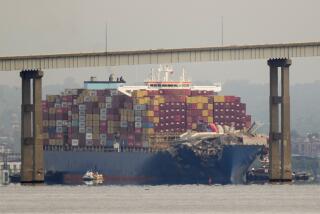Philippine Sea Disasters Haunt Travelers
- Share via
MANILA — Franklin Bornillo spends most of his time gambling and wakes up after nightmares to the sound of imaginary explosions.
The 27-year-old former seaman said his problems began after he survived the collision of the oil tanker he worked on with the Dona Paz ferry on Dec. 20, 1987.
The two vessels sank in the central Philippines in a fiery blaze that killed more than 3,000 people in the worst recorded peacetime sea disaster.
Very Risky Business
One year after the tragedy, sea travel is still a very risky business in the Philippines.
Storms, decrepit ships, overloading and disregard for maritime rules result in more than 100 accidents each year, shipping officials say.
“It was hell,” Bornillo, one of 26 survivors, said of the accident. “People were crying for help, and there was fire all over.”
The Dona Paz sinking emptied entire villages in rural Leyte and Samar.
Some families were then hit by subsequent sea tragedies.
Julio Gacita’s wife died on the Dona Paz. Ten months later, on Oct. 24, 1988, he died when the Dona Marilyn ferry went down in a typhoon.
Relatives of those who died on the Dona Paz said they have a hard time accepting their losses because so few bodies were recovered.
“I do not believe my son died,” said Marina Maceda, 46, who lost one son and two grandsons in the accident. Fighting back tears, the woman said she still believes that her son--listed as missing and believed dead--will return.
The Dona Paz disaster, which a government task force estimates claimed at least 3,389 lives, triggered a flurry of legislation and cries by politicians for tighter safety standards.
Query Takes a Year
It took the coast guard almost a year to conclude an investigation into the accident, and it was only after the Dona Marilyn sank last October, killing at least 120 people, that shipping authorities ordered a thorough check of all commercial vessels’ equipment and crew training.
About 75% of crews on several ships tested by the coast guard in recent months failed basic competence tests, a coast guard spokesman said.
“It was really disgusting,” said public affairs officer Lt. Francisco Mendoza.
One naval official who asked not to be named said it is common practice for unqualified crew members to buy fraudulent licenses to get jobs.
The coast guard and the Maritime Regulatory Authority said measures taken in the last year have made shipping safer, but other officials said little has changed.
Ferries are one of the most common and cheapest means of transportation around the Philippines’ more than 7,000 islands.
Capt. Gaudencio Empic of the M/V Tacloban City said some ships continue to break coast guard rules meant to prevent collisions in the busy Tablas Strait between Mindoro and Marinduque islands, the site of the Dona Paz disaster.
More than 1,000 people died in the same area in 1979 on another ferry, the Don Juan, when it also collided with an oil tanker and sank.
20% Called Obsolete
Officials estimate that 20% of the 10,000 cargo and passenger ships registered with the coast guard are obsolete.
The engine of the M/V Tacloban City, built in 1961 in Japan, broke down during the 360-mile voyage earlier this month.
Originally scheduled to make the trip in 25 hours, the vessel crept at quarter-speed into Manila harbor 32 hours after leaving.
Passengers, sitting and lying on steel bunk beds and cots crammed onto the decks, said breakdowns are common.
“If God wants me to die, I’ll die,” said Juanita Ignacio, 53, whose cousin died on the Dona Paz.
Empic said crews are now better trained to deal with emergencies, but some passengers estimated that up to half of the travelers would die if the ship sank.
At one point during the night, crew members padlocked the only two doors connecting the steerage-like “economy class” and the crew compartments.
One passenger looked in the direction of two small children standing by the railing.
“If this ship went down, so many would not make it.”
More to Read
Sign up for Essential California
The most important California stories and recommendations in your inbox every morning.
You may occasionally receive promotional content from the Los Angeles Times.













